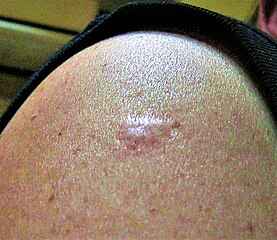Here’s The Truth Behind This Scar On People’s Upper Left Arm

A smallpox vaccine scar is a unique mark left at the site of vaccination. Typically, it appears as a small, round or slightly oblong indentation, often smaller than a pencil eraser. For some, the scar may be larger and raised due to a stronger immune response during the healing process.

Unlike modern injections that use thin needles to deliver fluid, the smallpox vaccine required a more invasive technique. Healthcare providers used a bifurcated needle — a tool with two prongs — which they dipped into the vaccine solution before repeatedly jabbing the needle into the skin. This method caused a noticeable injury, prompting the body to create scar tissue as it healed.
The live virus in the vaccine triggered a powerful immune reaction. As the body worked to fend off the virus, the injection site would scab over, often becoming itchy and sore. Eventually, the scab would fall off, leaving behind a pockmark-like scar as evidence of the body’s defense mechanisms.

While the upper left arm was the standard injection site, some recipients received the vaccine in less typical areas, such as the buttocks.
Though the vaccine saved countless lives, some individuals experienced mild, flu-like symptoms after receiving it, including fever, soreness, and swollen lymph nodes. Rarely, severe complications occurred, such as allergic reactions, skin infections in individuals with eczema, or brain inflammation.

Since smallpox vaccination is no longer routine, vaccine scars are largely a relic of the past. For those who want to reduce their scar’s appearance, options include using sunscreen to prevent discoloration, applying softening ointments, or seeking professional treatments like dermabrasion.
The smallpox vaccine, and the scars it left behind, remain a testament to humanity’s triumph over one of the deadliest diseases in history. Although smallpox is no longer a global threat, its story serves as a reminder of the power of vaccines in protecting public health.
Sources: MedicalNewsToday